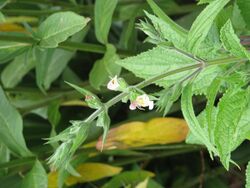Biology:Salvia koyamae
| Salvia koyamae | |
|---|---|

| |
| Scientific classification | |
| Kingdom: | Plantae |
| Clade: | Tracheophytes |
| Clade: | Angiosperms |
| Clade: | Eudicots |
| Clade: | Asterids |
| Order: | Lamiales |
| Family: | Lamiaceae |
| Genus: | Salvia |
| Species: | S. koyamae
|
| Binomial name | |
| Salvia koyamae Makino
| |
Salvia koyamae (Shinano-akigiri) is a perennial rarely found in the wild and native to the Japanese island of Honshu, where it has a close affinity to two other salvia species: Salvia glabrescens and Salvia nipponica. It was named by Tomitaro Makino, considered the "father of Japanese botany".
Salvia koyamae has a lax habit with decumbent stems reaching 2 feet or more that appear to creep, creating a loose ground cover about 1 foot tall. The large yellow-green cordate leaves are covered with fine hairs, and are 6 in long and 5 in wide with a 5 in long petiole. Pale yellow flowers grow in whorls, spaced on an inflorescence that can reach up to 1 ft long. Few flowers are in bloom at one time, but the heart-shaped leaves and yellow flowers make for an attractive plant. Around 1990 it was grown at the University of California Botanical Garden and introduced into horticulture soon after that.[1]
Notes
- ↑ Clebsch, Betsy; Barner, Carol D. (2003). The New Book of Salvias. Timber Press. p. 165. ISBN 978-0-88192-560-9. https://books.google.com/books?id=NM0iwB8GrQYC&pg=PA165.
Wikidata ☰ Q7406813 entry
 |

